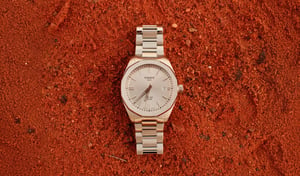If I asked you to compile a list of luxury watch brands, chances are, Rolex would sit at the very top – and that’s no accident. The British-founded Swiss watch manufacturer, which is currently worth over 25% of the entire watch market, has carefully cultivated its brand image over several decades, positioning itself as one of the most appealing status symbols in modern society. But with their long-standing sporting tradition, it begs the question: Why does Rolex avoid football (the biggest sport in the world)?
Rolex enjoys a reputation as one of the most aspirational luxury watch manufacturers. From milestone birthdays to milestone promotions, it exemplifies the pinnacle of excellence and desire, creating timepieces which, in their own words, are “A Crown For Every Achievement.” Although you’d be mistaken in thinking this reputation occurred overnight.
From the very beginning, wielding an iron fist concealed by a velvet glove, Rolex has maintained a brand strategy built on sponsoring athletes and events from the most remarkable sporting contexts. In fact, Rolex can claim to be one of the first brands to use ambassadors to promote their product, when Mercedes Gleitze wore a Rolex while attempting to swim across the English Channel in 1927. Associating themselves with peak performance creates a certain association between greatness as a whole and their brand in the mind of consumers.
RELATED: Rolex Explains Why It’s So Hard To Buy Their Most Popular Watches
This is the same reason why watch manufacturers often fight tooth and nail to become official timekeepers of the world’s biggest sporting events. Omega has the Olympics. Tissot has the Tour de France. And Hublot has European football.
Rolex, on the other hand, has focused its efforts sponsoring sports such as tennis, golf, yachting, equestrian, and Formula 1; carefully selecting acceptable candidates that are both played and watched by their target audience to join the family. In other words, they want to get in front of a crowd that can actually afford a Rolex.
As Rolex enjoys its reputation of aspirational luxury, these sports also enjoy a degree of exclusivity and prestige that more mainstream sports such as football simply do not have. When you think about the tradition of Wimbledon or the opulence of the Monaco Grand Prix, you also think about Rolex. Football is a sport for the masses, and Rolex wants to make it abundantly clear that it is not.
Despite this attitude Rolex appears to have, Hublot is more than capable of selling out limited-edition football timepieces that cost many multiples of a typical Rolex. If exclusivity and setting a high financial barrier to entry is the plan of the Swiss watchmaking giant, it doesn’t make much sense.
RELATED: Michael Caine’s Record-Breaking Rolex Proves He Was Ahead Of His Time
That being said, they probably weren’t entirely opposed to Cristiano Ronaldo sporting the Rolex GMT Master Ice at a conference in Dubai circa 2019. The watch is the most expensive timepiece the Geneva-based company has ever crafted with an RRP of US$485,350 (AU$675,578). Even though Ronaldo is not sponsored by Rolex, needless to say, pulling up with the GMT Master Ice didn’t exactly harm the reputation of either.
Yet another factor influencing Rolex’s decision to avoid football and other team sports is just that – they’re team sports. Tennis, golf, and Formula 1 all have one thing in common: they hero the individual athlete. Think about it. For every one of his 20 Grand Slam victories, Roger Federer has put on a new Rolex before receiving the trophy.
These individual sports provide frequent opportunities for podium and award ceremonies with unobstructed views of Rolex’s products. Coupled with the appeal of these sports and, as previously mentioned, the calibre of audience they attract, Rolex’s overall public-facing strategy will no doubt continue to further cement its already-established reputation. No further explanation required.















